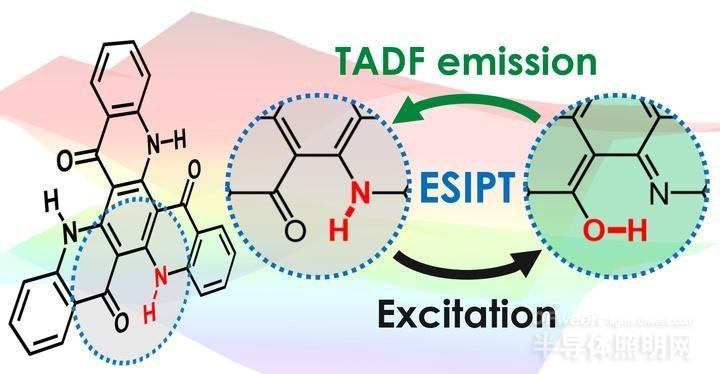Recent research has found that molecules that change their chemical structure slightly before and after emission provide a new and stable way to achieve efficient OLEDs.

The mechanism studied by researchers involves the reversible transfer of hydrogen atoms - that is, the transfer of its cation core - from one atom in the emitting molecule to another in the same molecule to create an environment that favors thermally activated delayed fluorescence (TADF).
Current molecular designs for TADF materials focus primarily on the combination of donor and acceptor units. But researchers at the Center for Organic Photonics and Electronics Research (OPERA) at Kyushu University in Japan have proposed an approach based on excited-state intramolecular proton transfer (ESIPT) to achieve efficient TADF without relying on the donor-receptor protocol described above.
When the emitting molecule is excited by optical or electrical energy, ESIPT occurs spontaneously.
Quantum chemical calculations by researchers have shown that TADF is unlikely to occur before hydrogen atoms are transferred. After hydrogen is transferred to different atoms in the same molecule, this forms a molecular structure capable of producing TADF. After the molecule emits light, the hydrogen is transferred back to its original atom. The molecule is then ready to begin repeating the process.
ESIPT results in the separation of the highest and lowest unoccupied molecular orbitals, resulting in a luminous efficiency of nearly 60% for TADF emission. The high external electroluminescence quantum efficiency of the OLEDs using this emitter is as high as 14%, indicating that an effective triplet harvesting effect can be achieved using ESIPT-based TADF materials.
The researchers said this was the first demonstration of an efficient TADF observed inside and outside the device.
The molecules used in this study were originally synthesized to produce light absorbing pigments.
This research can expand and accelerate the development of various TADF materials for high performance OLEDs.
It is only beginning to explore the advantages of this design strategy, but one of the particularly promising areas is related to its stability. Molecules known to be similar to the molecules studied this time are highly resistant to degradation, so researchers hope that these molecules will help improve the lifetime of OLEDs.

Car CD DVD Player Specification:
1. Function
- Auto unfolding detachable panel
- Compatible with DVD/DVCD/VCD/HDCD/CD-R/CD-RW/CD/MP4/MP3 etc format
- FM/AM MPX Reveier
- Auto Loading CD Mechanism, 3 Sec-direct Search CD
- SD/MMC USB2.0 Player
- Automatic Adjust Servo System
- ESP Electronic System
- High Power Output: 4X50Watts
- Channels RCA Output
- Preset EQ( POP-ROCK-CLASSIC-JAZZ)
- Colored LCD Digital Display
- Digital Song Selection
- 30 Presets Memory (18FM+12AM)
- ID3 Display
- Electronic Volume Control
- Mute/Loudess Control/Clock
- Last position Memory
- USB Mobile Charger
- OPtion: AM/RDS/Bluetooth/Subwoofer control
car dvd player, Car CD Player, car radio adapter, car dvd System
Jiangmen soundrace electronics and technology co.,ltd. , https://www.soundracegroup.com